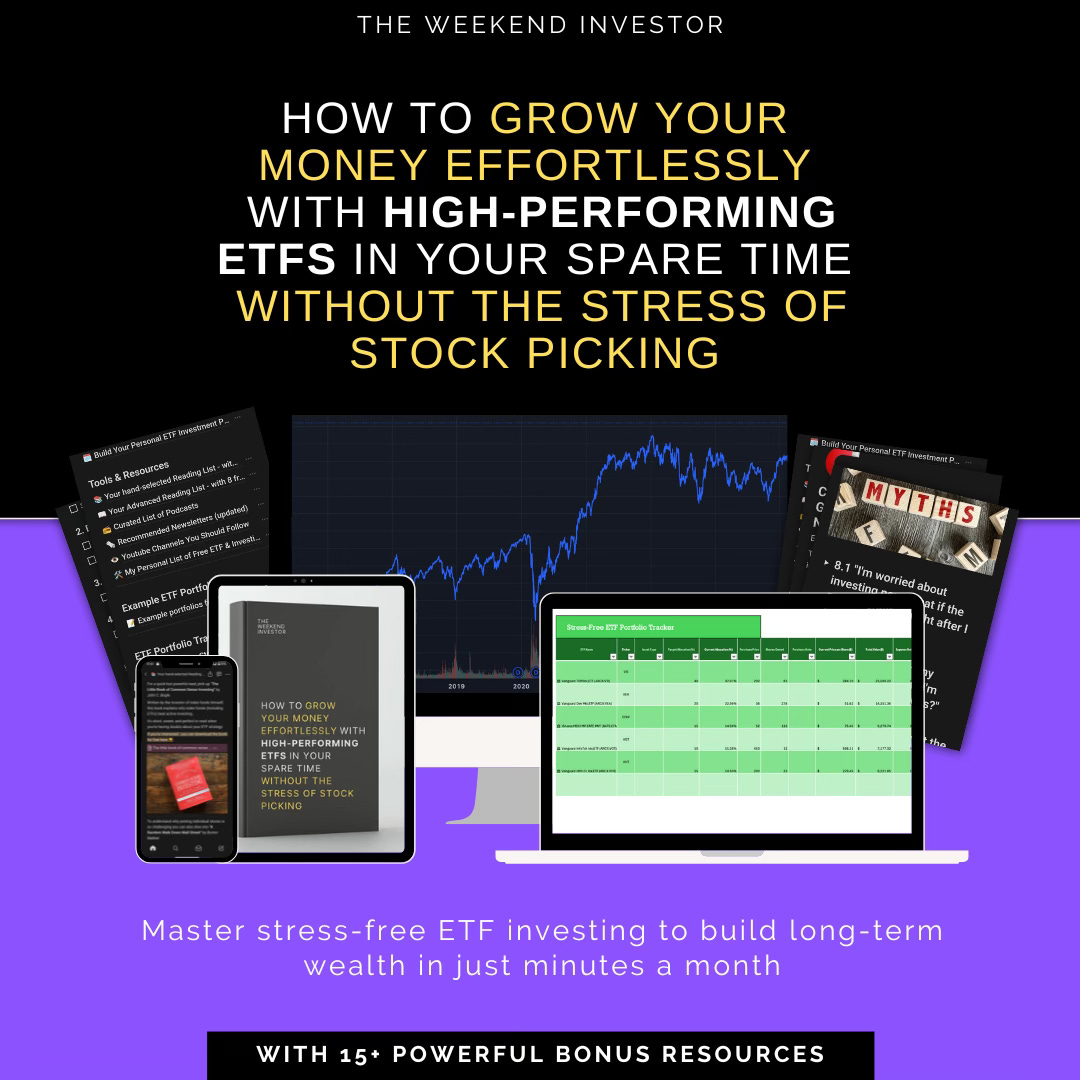The Great Wealth Migration: How Regular Investors Can Profit From The Biggest Market Shift in History
#40 A Young Professionals Weekly Investing Insights
WARNING: The biggest wealth transfer in history is happening right now. Some investors will lose everything, while others will build generational wealth.
This guide will show you which side to be on. (+ I’ve got a little something for you at the end)
In 1995, would you have believed:
An online bookstore would crush Walmart
A DVD-rental startup would kill Blockbuster
An electric car maker would outvalue Ford, GM, and Toyota combined
Sounds crazy, right?
What's happening now is 100x bigger.
In the next 5 years:
40% of the S&P 500 could disappear
Most bank branches will become obsolete
Traditional car makers might collapse
Commercial real estate could implode
Yet most retirement accounts are loaded with exactly these risks.
Is your 401(k) or IRA in danger? Probably.
But there's a solution.
In this guide, you'll discover:
Which "safe" blue-chip stocks could soon be worthless
A simple 4-ETF strategy to protect and grow your wealth
Why traditional investment advice has become dangerous
How regular investors can turn disruption into profit
Silicon Valley Bank said they were "completely safe from disruption."
Three months later? Bankrupt.
The warning signs were there.
This guide will show you how to spot them - and what to do next.
Part 1: Understanding the Big Picture (In Plain English)
Why This Time Is Different
You've probably heard "this time is different" before. Usually, it's not.
But sometimes, massive shifts really do change everything.
Think:
1800s: Industrial Revolution
1920s: Mass production and electricity
1950s: Suburbanization
1990s: Internet
Today: AI + Digital Everything + Clean Energy
What makes today unique? The speed and scale of change.
Let's Break It Down with a Simple Example:
Think about how you lived in 2019 versus now:
Shopping habits? Probably more online
Work? Likely more remote
Entertainment? More streaming
Payments? More digital
Transportation? More delivery services
Now multiply these changes by 1000x for businesses.
Companies built for the old world are dying - while new ones are growing faster than ever.
Three Massive Shifts Reshaping the Investment World
1. The Digital Revolution: Everything's Going Online
The way we handle money is changing dramatically. Think about your local bank branch - when was the last time you actually needed to visit?
Digital banks like Revolut and Chime now serve millions of customers without a single physical branch.
Meanwhile, traditional banks are spending billions maintaining expensive branch networks that fewer people use each year.
The numbers tell a shocking story:
Young people are five times more likely to use digital banking than visit a branch. Even more surprising, 80% of millennials say they'd rather bank with tech companies than traditional banks.
Why? Traditional banks spend $15-20 to process a single transaction - while digital banks spend just $2-3.
What This Means for Your Money: If you own index funds or mutual funds, roughly 10-15% of your money might be sitting in traditional banks. These companies are spending billions on branches while losing customers to digital competitors.
2. The Clean Energy Transformation
This isn't just about saving the planet anymore - it's about pure economics.
Solar power has become cheaper than coal in most places around the world, and the cost keeps dropping.
Traditional energy companies are sitting on trillions in assets (like oil fields and coal mines) that might soon be worthless.
What This Means for Your Money: Energy companies make up 5-10% of most index funds. Many of these companies are valued based on oil and gas reserves they might never be able to sell.
3. The AI Revolution
Of course this one had to be in here.
Artificial Intelligence isn't just science fiction anymore - it's transforming entire industries.
AI can now handle tasks that used to require expensive professionals, from analysing legal documents to diagnosing common medical conditions.
This isn't about robots taking over; it's about traditional business models becoming obsolete.
Part 2: Where Your Money Is Most at Risk
Traditional Banks: A Crumbling Empire
JPMorgan Chase spends $2.5 billion every year just maintaining its branches.
Meanwhile, digital banks are serving more customers at a fraction of the cost.
Think of it like Netflix versus Blockbuster.
Except this time, it's your money at stake.
Here are some warning signs to watch:
Empty bank branches in your neighborhood
Your bank struggling to offer modern digital services
Young people laughing at the idea of visiting a branch (this is not a joke!)
Retail: The Amazon Effect
Remember when shopping malls were packed every weekend?
Those days are ending.
But this isn't just about shopping habits - it's about the entire retail ecosystem.
Major retailers are caught in a deadly spiral: They're stuck paying for expensive stores while customers shop online.
Every empty storefront means less revenue to pay for:
Expensive long-term leases
Mountains of unsold inventory
Massive pension obligations to former employees
The Auto Industry's Electric Shock
Tesla isn't just winning because they make electric cars.
They're winning because they think differently about what a car company should be.
Traditional automakers are spending more money on retiree pensions than on inventing the future.
Here's a telling detail: The average Mercedes buyer is 66 years old. The average Tesla buyer is 42.
One company is selling to the past; the other is selling to the future.
Commercial Real Estate: The Perfect Storm
The office building where you work might be worth a lot less than you think. Three huge trends are hitting at once:
Remote work is becoming permanent
Online shopping is killing retail spaces
Rising interest rates are making it harder to refinance property loans
It’s not just about empty buildings thought - it's about the entire financial system. Banks own the mortgages on these buildings. Insurance companies own the loans. Your retirement fund probably owns the real estate companies.
The Hidden Danger? When commercial real estate struggles, it creates a domino effect through the entire financial system.
This is why it matters even if you don't own real estate directly.
Part 3: Your Protection & Growth Strategy (Simple But Powerful!)
Connecting the Dots: Why Traditional Advice Isn't Enough
Remember all those disruptions we discussed earlier?
Here's the challenge:
Banking is being disrupted
Retail is being transformed
Auto industry is changing
Real estate is struggling
Traditional energy is declining
So why not just invest in all the disruptors?
Here's the truth: Picking individual winners is incredibly risky. For every Netflix (up 40,000%) there are dozens of companies that failed.
Remember:
Webvan in online groceries? Bankrupt.
Groupon in digital deals? Down 95%
GoPro in digital cameras? Down 90%
Snapchat in social media? Down 80%
The Smarter Approach: Let the Market Work for You
Instead of trying to pick winners, we're going to use a simple but sophisticated strategy that:
Protects you from disruption
Gives you exposure to winners
Manages your risk
Keeps costs low
Here's how:
1. Your Core Foundation (60-80% of Your Portfolio)
Primary investment: Low-cost broad market ETFs tracking the S&P 500 or Total Market
Examples of this could be VOO (Vanguard S&P 500 ETF) or VTI (Vanguard Total Stock Market ETF)
You can also add further diversification through:
International market exposure (30-50% of core): VXUS, VEA or similar
Why This Works With Disruption?
The S&P 500 automatically adapts to change. Look at these facts:
In 1990, IBM and GE were the largest companies
In 2000, it was Microsoft and GE
In 2010, it was Exxon and Apple
Today, it's Apple, Microsoft, and other tech leaders
By owning a broad index, you:
Automatically remove dying companies
Add new winners as they grow
Never miss the next big thing
Avoid dying industries naturally
2. Your Future Growth Bucket (20-40% of Your Portfolio)
A. Technology & Innovation
Focus areas:
Cloud computing ETFs (e.g., WCLD, SKYY)
Artificial Intelligence ETFs (e.g., BOTZ, ROBO)
Fintech ETFs (e.g., FINX)
Cybersecurity ETFs (e.g., HACK, CIBR)
B. Healthcare Innovation
Consider ETFs focusing on:
Biotechnology
Medical devices
Healthcare technology
Genomics research
Optional Additional Sectors:
Clean Energy (5-10%)
Digital Infrastructure (5-10%)
E-commerce (5-10%)
Why These Sectors Specifically?
We're targeting two areas that benefit from disruption but with much lower risk than buying individual companies:
But you can also pick other sectors which you believe to be poised to dominate the future.
Want to Master ETF investing in 7 days? Join my free Quickstart and learn the exact system for building wealth with less stress. No fluff, just proven strategies.
→ Start Free [Link]
Why This Simple Strategy Is Actually Sophisticated
Built-In Disruption Protection
Bad companies get removed from indexes automatically
You own disruptors as they grow large enough
No need to predict winners
Natural evolution toward growth areas
Protection From Your Own Biases
No emotional trading
No chasing trends
No panic selling
No analysis paralysis
Addressing Common Concerns
"Am I missing out on hot trends?"
No - you own them as they become real businesses
Remember: Most trending investments fail
You get the winners automatically
"What about all the disruption you mentioned?"
Dying companies get removed from indexes
Winners get added automatically
You're always invested in the strongest companies
"Is this too simple to work?"
Warren Buffett recommends this approach
Most professional investors can't beat it
Lower costs mean higher returns
The Bottom Line: Your Call to Action
Here's the truth:
The biggest risk to your money isn't market crashes or inflation.
It's having your wealth slowly eroded by investing in dying industries.
The good news?
You don't need to become a day trader or stock picker.
Simple, thoughtful changes to your ETF portfolio can protect and grow your wealth.
Remember:
Small changes now can mean huge differences later
Regular review beats perfect timing
Understanding beats speculation
Steady progress beats dramatic moves
What's Coming Next Month:
Specific ETF recommendations
Risk assessment checklist
Rebalancing calculator
Reader Q&A
Special Bonus:
Subscribe now - if you want - and get our "Future-Proof Portfolio Checklist" - a simple tool to evaluate any investment in 5 minutes!
Here it is for you: Access Portfolio Checklist
Ready to master ETF investing?
"How to Grow Your Money Effortlessly with High-Performing ETFs"
The complete system for busy professionals who want to build lasting wealth without the stress.
You'll learn how to create a portfolio that practically runs itself, select winning ETFs with confidence, and automate your way to financial freedom.
Inside you'll get:
The exact ETF selection system our community uses to outperform
Done-for-you portfolio templates and automation guides
Market crash defense strategy that protected our members in 2022
Private community access for real-time insights
Plus 15+ premium investing resources
Join the others who've transformed their investing journey.
[Save 70% Today - Special Reader Discount]
Oh and here are some other newsletters I enjoy reading and recommend:
This newsletter is for informational purposes only and is not intended as financial advice. The insights provided are illustrative and should not be the sole basis for investment decisions. Readers should conduct their own research and consult professional advisors before investing. The authors and publishers are not liable for any financial losses resulting from actions taken based on this content. Investing in the stock market involves risk, including potential loss of capital.








